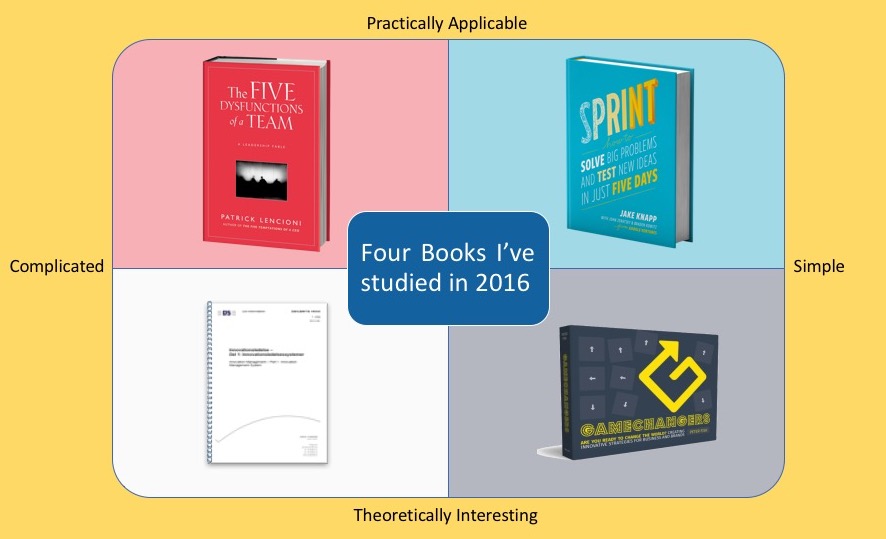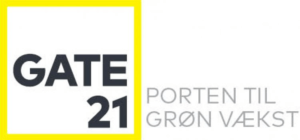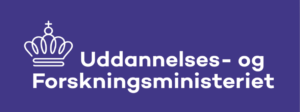
Revitalisation of our Network Group with Zoom, Mural and Excellent Facilitation
We finally got a meeting in the network again – and it was much needed! Throughout the network’s 7-year lifespan, all our
In 2016, I’ve read around 30 innovation books. Four of them stand out. Here is why.
The books are shown in the grid below. The grid has two axis:
[su_spacer size=”5″]

[su_spacer size=”5″]
So here we go, from top left to bottom right.
[su_spacer size=”5″]
I am an avid Kindle reader – and this classic “The Five Dysfunctions of a Team – A Leadership Fable” by Patrick Lencioni is marvellous. The funny thing is, that while I was reading it, I was doing an assignment with the leadership team of Roche Innovation Center Copenhagen, together with Berit Sander, a very experienced psychologist. At our first meeting she said: “I have this great model from Lencioni, which might be useful…” – “Lencioni?”, I said, “I’m just reading his book!” What a marvellous conicidence that was. The model that is used throughout the book is this:
[su_spacer size=”5″]
[su_spacer size=”5″]
The book is written as a story, where we follow a newly appointed CEO’s efforts to create a cohesive and efficient leadership team. Team dynamics are complicated – this is why I classified the book as such. It is highly applicable, though – and the book is refreshingly free from “model overload”. If you only read one book about team dynamics, this is definitely recommended. We used it with great effect in our work.
[su_spacer size=”5″]
“Sprint – Solve Big Problems and Test New Ideas in Just Five Days” is written by Jake Knapp, John Zeratsky and Braden Kowitz from Google Ventures. It’s a no-frills and easy-to-use blueprint for how you engage a dedicated team to create a tested prototype of virtually anything in five intensive days. I was so thrilled by the book that I bought it as a “real” book, after having read it in almost one sitting at my Kindle. A sprint process looks like this:

Soon after, I had a meeting with Line Storelvmo Holmberg from Vestas, whom I worked with previously. Line had contacted me because she wanted to develop a new version of a technical software package with her team. “Why don’t we do a Sprint?”, I said, and continued: “In five working days, we can have a prototype of your software, that has been tested with five users!”. She was on to the idea immediately.
In the beginning of November, we did a sprint with a dedicated team of Vestas experts. For five days, we worked intensively to develop and test a prototype. Before we knew it, we were ready to contact a patent attorney with our new business idea. The Sprint book was an extremely good guide in this process.
[su_spacer size=”5″]
I have written several blog posts about the European Innovation Management Standard. A lot of work has put into this, and the standard is in my view a very useful document. It is very boring to read, however, which is why I’ve placed in the lower left corner: Complicated and theoretically interesting.
In other words, only the ones that have a particular interest in this field would bother to read it, let alone know that it exists. Since I bother, I have read it thoroughly, and have developed the INNOCULTURE board game from it, together with Copenhagen Game Lab. I have played INNOCULTURE with e.g. Designskolen Kolding and Netværk Danmark, with great success, and am in the process of writing an abbreviated version of the 160-page document, in collaboration with Dansk Standard.
[su_spacer size=”5″]
[su_spacer size=”5″]
If you want to read the European Innovation Management Standard, you may buy it here. And if you don’t have the patience to read it, stay tuned for my abbreviated version, or contact me, if you want to have a demo of the INNOCULTURE game. You may read about the different options to get engaged with INNOCULTURE here.
[su_spacer size=”10″]
“Gamechangers” by Peter Fisk has the same format as Osterwalders Business Model Generation started (and indeed many, many innovation books have since adopted): A landscape book with plenty of pictures. Peter Fisk is a fantastic presenter, which I had the pleasure to meet when he was giving a talk in Odense:
[su_spacer size=”5″]
[su_spacer size=”5″]
His book is jam packed with 100 case studies of gamechangers (=disruptive innovators) from 10 different sectors, and it’s all nicely topped off with models and 16 different canvases. This is the business model canvas on steroids!
His website is a plethora of material to inspire your innovation. I put it in the lower right corner, though, because it is almost too much :-) – where to start and how to apply all these wonderful canvases becomes a study in its own right, and therefore not easy to put into practical use right away. We have applied some of the Gamechanger concepts with Krüger.
All these books are worthwhile reads, and I recommend them full-heartedly. The following 4 questions may guide you:
[su_spacer size=”20″]
We can do a sprint process with your team, to create a tangible and tested prototype in just 5 days. The advantages of doing a sprint include:
Read more about how we do sprints here.
[su_spacer size=”5″]
We have done numerous leadership and strategy development projects, with e.g. Roche Innovation Center Copenhagen, TEC, LEO Pharma, and Knud E. Hansen.
[su_spacer size=”5″]
Contact us, if you want a refreshing and insightful keynote about innovation.
[su_spacer size=”5″]
There are many ways to get started with systematic innovation management:

We finally got a meeting in the network again – and it was much needed! Throughout the network’s 7-year lifespan, all our

The collaboration with Finn Kollerup was very rewarding for us. He inspired our participants to think about their everyday challenges in a new

Our task was to facilitate an efficient process and collect the results from a high-profile meeting. A special factor was that the schedule